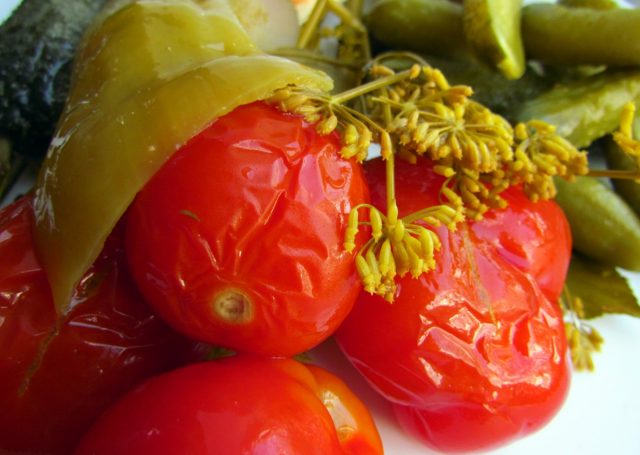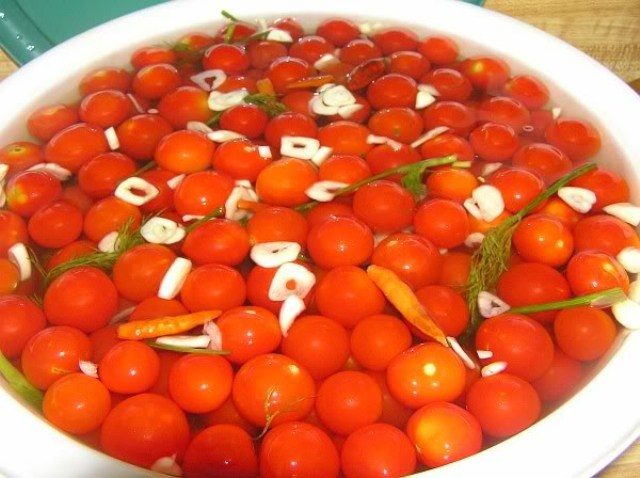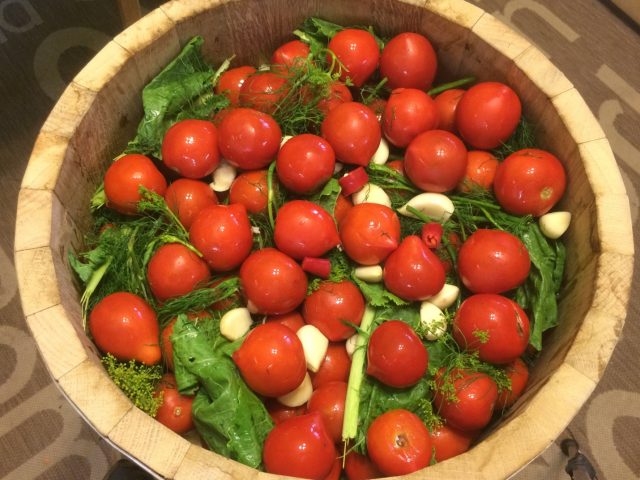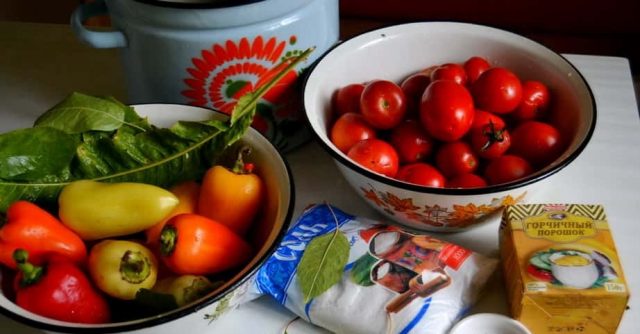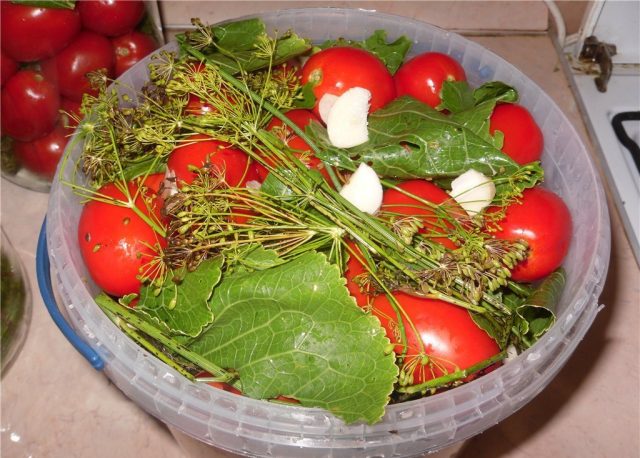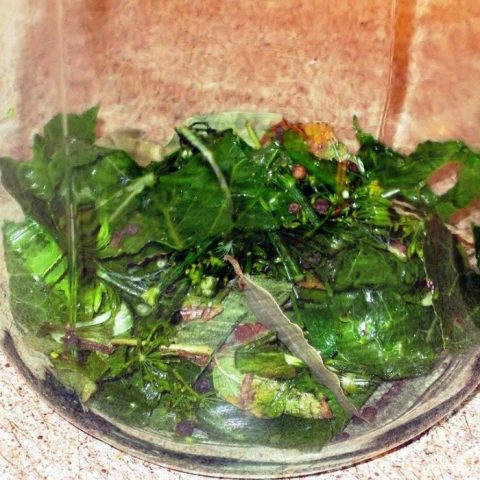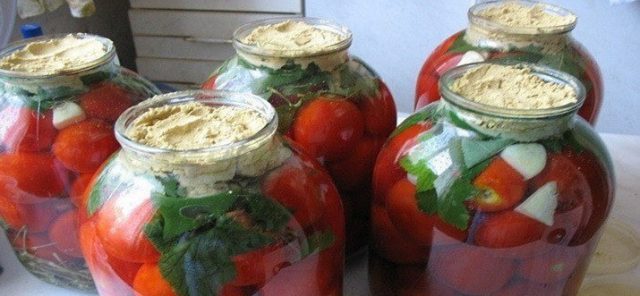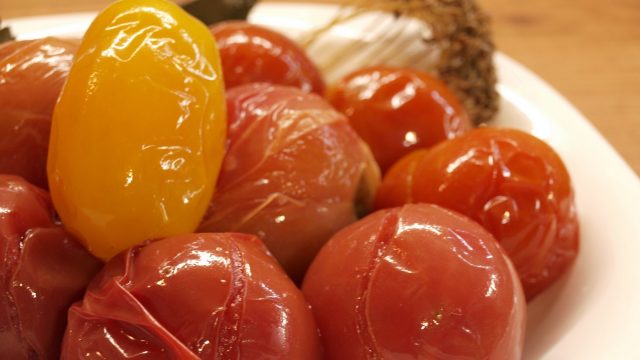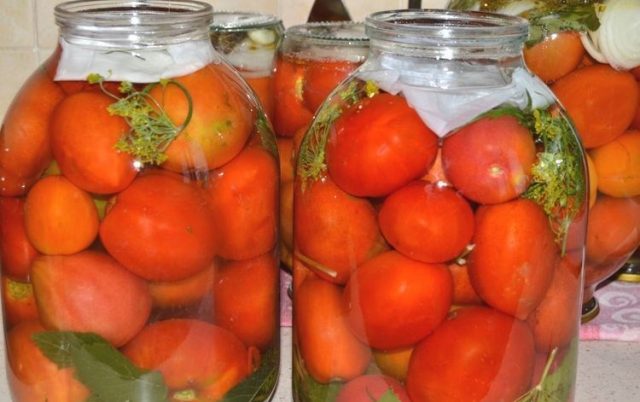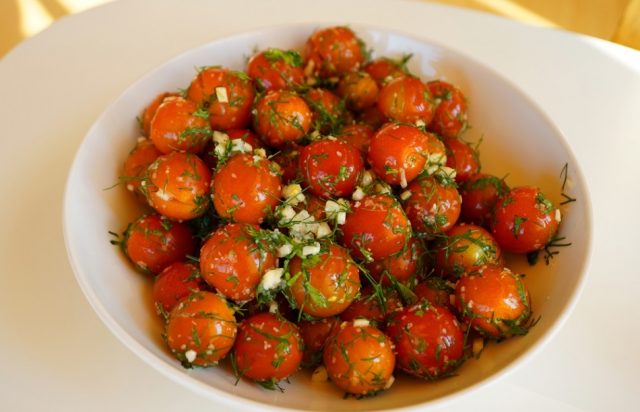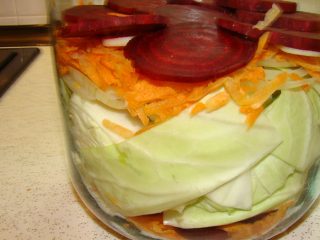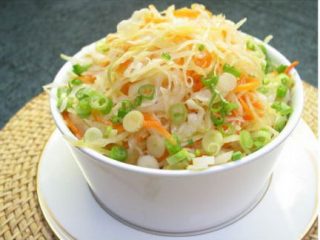Content
- 1 How to ferment tomatoes at home
- 2 How to ferment tomatoes in a saucepan
- 3 Tomatoes pickled in a pan with bell pepper
- 4 Tomatoes pickled for the winter in a barrel
- 5 Pickled tomatoes for the winter in a bucket
- 6 Instant pickled tomatoes
- 7 Tomatoes pickled with garlic and herbs
- 8 Recipe for pickled tomatoes with hot peppers
- 9 Tomatoes pickled for the winter with celery
- 10 Tomatoes for the winter, pickled with apples
- 11 Tomatoes pickled in jars with horseradish, like barrels
- 12 Recipe for tomatoes pickled for the winter in jars
- 13 Tomatoes pickled for the winter with mustard
- 14 Pickled tomatoes with aspirin for the winter
- 15 Pickled tomatoes for borscht for the winter
- 16 Pickled tomatoes for the winter: recipe with basil
- 17 Tomatoes for the winter, pickled with coriander and cloves
- 18 Rules for storing pickled tomatoes
- 19 Conclusion
Times change, but pickled tomatoes, as an ideal Russian appetizer for the table, both on weekdays and on holidays, remain unchanged. In ancient times, dishes were not pampered with their variety, so tomatoes were fermented exclusively in wooden barrels. Today, apartment conditions are not well adapted to such bulky volumes, and the imagination of housewives has no limits - jars, pans, buckets, and even plastic bags are used to ferment tomatoes.
How to ferment tomatoes at home
There are two fundamentally different approaches to pickling tomatoes.The first is traditional, and is closest to the actions that our great-grandmothers performed to preserve vegetables for the winter, using wooden barrels. Its main advantage is the fact that vegetables retain and even increase a large amount of useful substances. Well, the taste, as well as the aroma of pickles made in this way, deserves the highest marks. It’s not for nothing that many modern recipes for pickled tomatoes are called “barrel-like.” But the main disadvantage of this fermentation method is the long production time - at least 20-30 days. But pickled tomatoes are stored in favorable conditions for a long time - until spring.
Other recipes also deserve attention, if only because they make fermenting tomatoes quite quickly - after just 3-4 days you can already taste the tomatoes. And according to some recipes, they are ready for use within a day after preparation.
Despite some significant differences, both approaches have common manufacturing rules that must be followed to ensure that pickled tomatoes taste good and can be stored for a sufficiently long time.
- Tomatoes, as well as all other vegetables and herbs that are used for pickling, must be carefully sorted, removing all fruits, even those with slight damage.
- Tomatoes are fermented in different degrees of ripeness: from ripe to completely green. But only fruits of uniform ripeness can be fermented in one container, since the fermentation time depends on the ripeness of the tomatoes.Ripe tomatoes ferment much faster, in 20-30 days in suitable conditions.
- The color of tomatoes does not play a special role when fermenting. But, since yellow and orange fruits, as a rule, have more sugar content, it is a little faster to ferment them.
- All components must be thoroughly rinsed several times in cold water, even with a brush, and then rinsed with slightly warm water.
- When making brine, it is advisable to boil it in any case, then cool and strain to remove possible contaminants contained in the salt.
- The cleanliness of the dishes in which vegetables are fermented also plays an important role. All buckets, barrels and pans must be washed with a soda solution and then rinsed with boiling water.
- There is no need to be shy about using a variety of spices and aromatic herbs for fermentation, remembering that they not only improve the taste of pickled tomatoes and increase their nutritional value, but also increase their shelf life.
How to ferment tomatoes in a saucepan
In a modern kitchen, a saucepan is perhaps the most convenient vessel for fermenting tomatoes in the traditional way. Because buckets, and even more so barrels, may simply not fit in the cramped space of the kitchen. But for fermenting tomatoes in jars, a different technology is often used.
The most important thing for a recipe for pickled tomatoes in a saucepan is to prepare the minimum required set of spices, although as mentioned above, the more aromatic herbs and seeds are used, the tastier the pickled tomatoes will be.
So, for a 10 liter pan you will need:
- Tomatoes - how many will fit in the pan, on average about 7-8 kg;
- 3-4 leaves of horseradish;
- 150 g of dill (inflorescences with stems and a small amount of greenery, as well as seeds);
- 4-5 heads of garlic;
- 25 currant and cherry leaves;
- about 10 oak leaves;
The brine is made by adding 70-90 g of salt per 1 liter of water.
Fermenting tomatoes according to the recipe is not difficult, but there are several tricks that will help make the preparation especially tasty.
- Place 2/3 of horseradish, cherry and currant leaves, several cloves of garlic, as well as stems, inflorescences and dill seeds on the bottom of the prepared pan.
- Then they begin to densely lay the tomatoes, sprinkling them with the remaining herbs, garlic and spices.
- It is better to place larger tomatoes at the bottom so that smaller ones can cover the resulting voids.
- The vegetables laid on top are covered with the remaining horseradish leaves and other herbs.
- Prepare a solution by boiling water with salt and cooling it to room temperature.
- Pour brine over the stacked tomatoes. It should completely cover all the vegetables.
- If suddenly there is not enough brine, you can add clean cold water on top.
- The top of the pan is covered with gauze or clean cotton cloth, and then covered with a lid.
- If there is no lid or it does not fit tightly, then the tomatoes will definitely need pressure to form a layer of liquid to limit air access to the vegetables.Attention! It should be borne in mind that without a load, the top tomatoes will rise up and, upon contact with air, will oxidize and be unfit for consumption.
- To minimize the crushing of fruits under pressure, it is necessary to remember that the pressure pressure should be around 10% (1 kg of load per 10 kg of tomatoes). You can use a plate with a jar of water placed on it.
- Then the fun begins. After all, it is in the first week that the most basic process of fermenting tomatoes occurs.
- For the first 2-3 days, tomatoes are kept in a relatively warm room, and then sent to a cool, but not cold, place.
- The process of pickling tomatoes should be monitored every day if possible. If the gauze becomes covered with a white coating of mold, then it must be thoroughly rinsed with cold water and the vegetables should be covered with it again.
- In a place that is too cold (from 0° to +4°+5°C) the fermentation process will slow down greatly, and the tomatoes will be ready only after a month or two. If there is nowhere to rush, then this will be the most optimal way out of the situation.
- It is best to wait until the main fermentation process is completed (after about 8-10 days) in a relatively cool place (about +15°C), and then send the pickled tomatoes to a cold place (you can even go to the balcony).
- Tomatoes fermented according to this recipe can be served 30-40 days after production.
Tomatoes pickled in a pan with bell pepper
Lovers of sweet bell peppers can easily make it one of the components of the recipe when fermenting tomatoes. This addition will add richness to the aroma of the finished dish, and the taste will acquire additional sweetish notes.
For 10 kg of tomatoes, usually add 1-2 kg of bell pepper.
In this recipe, vegetables are fermented using a slightly different technology.
- Tomatoes, as usual, are placed together with herbs and spices in a pan.
- Peppers, freed from the seed chambers and cut into halves or quarters, are also placed there.
- Then sprinkle the vegetables with salt and shake lightly.
- Lastly, purified cold water is simply poured into the container almost to the very brim.
- Tomatoes fermented in this way in a pan of cold water are left at room temperature for several days, after which they are put away in the cold.
Tomatoes pickled for the winter in a barrel
Nowadays, rarely does anyone ferment tomatoes for the winter in wooden barrels, but if you really want to and have space in the house (cellar or balcony), you can try fermenting tomatoes in a food-grade plastic barrel.
In general, the fermentation technology for this recipe is practically no different from that described in detail above. Simply, the quantity of all ingredients is increased in proportion to the increase in the size of the barrel, compared to a 10-liter pan.
The top layer tomatoes are placed 3-4 cm below the top level of the barrel so that they are completely covered with brine. It is better to cover the vegetables on top with large horseradish leaves, and, if possible, oak leaves.
Since the barrel is difficult to move from place to place, it is immediately installed in a relatively cool room, for example, on a balcony in the fall.
Depending on the ambient temperature, the fermentation process will occur faster or slower, but in one and a half to two months it will be completed in any case. Traditionally, special attention is paid to pickled tomatoes in the first two weeks of the process - the cloth with which they are covered is removed and washed. In the future, pickled tomatoes no longer require special attention.
Pickled tomatoes for the winter in a bucket
Using exactly the same traditional recipe, you can ferment tomatoes in buckets, using not only enamel buckets, but also plastic buckets of various shapes and sizes, from 5 to 12 liters, which have been very common in recent years.
Moreover, small buckets can also be used to ferment tomatoes in another, quick way.
Instant pickled tomatoes
This recipe for pickled tomatoes is becoming increasingly popular, since you can start tasting aromatic tomatoes 3-4 days after pickling.
The following products will be required:
- 3 kg of elastic and strong small tomatoes;
- a small bunch of cilantro, parsley and dill;
- 5 cloves of garlic;
- 1 teaspoon of dry oregano herb;
- 15 black peppercorns;
- 2 bay leaves;
- 2 cloves.
According to this recipe, you can ferment tomatoes either in a saucepan or in glass jars.
- Place the tomatoes in the selected container and fill with cold water so that the fruits are completely covered. This is done in order to determine how much brine will be needed for production.
- The water is drained, its volume is measured and a brine is prepared, based on the fact that one liter of water will require 60-70 g of salt.Comment! This makes about 2 heaping tablespoons.
- The brine is heated to 100°C and then cooled slightly.
- While the brine cools, the tomatoes, along with herbs and spices, are placed in prepared containers.
- After filling, they are filled with still warm brine.
- The containers are covered with gauze and, if possible, a weight is placed on top.
- If the load cannot be placed, then the container must at least be tightly covered with a lid.
- Depending on the size of the tomatoes, they are fermented for 4 to 7 days.
After this period, pickled tomatoes must be stored in the refrigerator or other cold place.
Tomatoes pickled with garlic and herbs
Actually, all the components for this recipe can be taken from the previous one. But the manufacturing technology is slightly different.
- The garlic is crushed using a press, and the greens are finely chopped with a sharp knife. Mix the greens and garlic well.
- A cross-shaped cut is made in each tomato in the area where the stalk joins and filled with a mixture of garlic and herbs.
- Place the chopped vegetables, cut side up, into prepared containers, topping them with spices and spices as usual.
- Prepare a saline solution and pour it over the tomatoes while warm, so that they are completely hidden in it.
- Cover with a lid and leave in a warm place for 24 hours.
- After which, pickled tomatoes can even be placed on the holiday table and stored in the refrigerator.
Recipe for pickled tomatoes with hot peppers
When tomatoes are fermented according to this recipe, 2-3 pods of hot pepper are added to traditional spices per 10 kg of fruit.
In addition, you can try ready-made pickled tomatoes the very next day after production if you use the following trick. Before placing the tomatoes in a container for pickling, make a small cut in the shape of a cross on each of them, or pierce them in several places with a fork. And then pour the prepared tomatoes with still hot brine, at a temperature not lower than +60°C.
Tomatoes pickled for the winter with celery
This recipe differs only in the addition of the required pickling spices: 50 g of celery per 5 kg of tomatoes.Tomatoes can be fermented using both traditional and quick methods.
Tomatoes for the winter, pickled with apples
It’s very tasty and healthy to add apples when fermenting tomatoes according to the recipe. There is nothing unusual in this combination, given that in ancient times almost all available vegetables and fruits were fermented together in one barrel. In this case, the recipe for soaked tomatoes implies that 1 kg of apples will be used for 5 kg of vegetables.
Tomatoes pickled in jars with horseradish, like barrels
The most common way for any housewife is to ferment tomatoes for the winter in a regular three-liter jar. And this is not at all difficult to do even according to a traditional recipe, when as a result the taste of pickled tomatoes will be just like those from a wooden barrel.
For one jar you will need the following products for pickling:
- 1500 g cream tomatoes;
- a bouquet of herbs consisting of: horseradish leaves, black currants, cherries, stems and inflorescences of dill;
- 1 small root of horseradish;
- 10 black peppercorns;
- Bay leaf;
- 3 peas of allspice;
- 2-3 cloves.
Tomatoes fermented in jars will be just like barrel tomatoes if you prepare them according to the following recipe.
- The bottom of the jar is filled with stems and leaves of herbs cut into pieces, 6 cm long. Spices and horseradish rhizome cut into small pieces are also added there.
- Then prepare a saline solution: about 60 g of salt are dissolved in 250 ml of boiling water.
- Pour hot brine over herbs and spices.
- Then they begin to place the tomatoes, and add some more herbs in the middle and at the end.
- After filling the jar with tomatoes, pour regular cold water on top under the neck.
- Cover with a plastic lid and carefully roll it for a while so that the salt is distributed more evenly throughout the entire volume.
- Then put in a warm place for 3 days, avoiding direct sunlight.
- Then the jar must be moved to the refrigerator and left alone for at least 2-3 weeks.
- At the end of this period, pickled tomatoes are already able to reveal their full flavor bouquet.
Recipe for tomatoes pickled for the winter in jars
Pickled tomatoes prepared according to any of the recipes described here require temperature conditions of 0°+3°C for storage. If there are no such conditions, then it is easier to preserve pickled fruits for the winter.
To do this you need to proceed as follows:
- Ferment tomatoes according to any recipe you like.
- After 3-5 days after aging in a warm place, pour the brine into a separate pan and heat to a boil.
- Rinse tomatoes with seasonings in a colander with hot boiled water.
- Pour hot brine over the tomatoes, wait 5 minutes and drain.
- Heat the brine again to a temperature of 100°C and pour it over the tomatoes.
- Repeat these operations a total of three times.
- The third time, immediately wrap up the pickled tomatoes for the winter.
Tomatoes pickled for the winter with mustard
The recipe is ancient, but it enjoys such popularity that many modern dishes cannot even dream of. And all due to the unforgettable taste of the finished snack.
The amount of ingredients is calculated for a 10 liter bucket or pan:
- 5 liters of water;
- About 6 -7 kg of tomatoes (depending on size);
- 50 g dry mustard;
- 150 g salt;
- 250 g sugar;
- 8 pieces bay leaves;
- 1/2 teaspoon each of allspice and black pepper;
- horseradish and black currant leaves.
They make fermented beer quite traditionally:
- Place the tomatoes with spices in a bucket, sprinkle with horseradish leaves, currants and spices.
- Boil water with salt and sugar. After cooling, thoroughly stir the mustard powder into the brine.
- Let the brine sit and pour it over the tomatoes.
- Cover the top with clean gauze and the necessary weight.
Pickled tomatoes with aspirin for the winter
As already noted, fermentation is a completely natural process, which does not require additional acids, but only vegetables and salt. Sometimes sugar is added for taste.
But for many housewives, the recipes used by their mothers and grandmothers, including pickled tomatoes with aspirin, are still valuable.
Fermenting tomatoes in this way is very simple - pour three crushed aspirin tablets into a three-liter jar with packed vegetables and herbs and fill with brine. After which the jars are covered with plastic lids and placed in a cool place. Pickled tomatoes are ready on average in 2-3 weeks, but they are stored for a very long time - until spring.
Pickled tomatoes for borscht for the winter
Probably, it is unlikely that anyone will prepare pickled tomatoes specifically for borscht. But if the tomatoes made a few months ago seem to be over-acidified, then you can grind them through a meat grinder, and it will be a wonderful borscht dressing.
Pickled tomatoes for the winter: recipe with basil
You can ferment tomatoes according to another interesting recipe without using water.
You need to prepare:
- 3 kg of tomatoes;
- 200 g salt;
- 150 g sugar;
- 50 g each of basil and tarragon leaves;
- currant and cherry leaves - by eye.
Fermenting tomatoes according to this recipe is very simple.
- The tomatoes are washed, dried, and pricked with a fork in several places.
- Place in a prepared container, sprinkling with a mixture of salt, sugar and chopped herbs.
- Cover with clean gauze and place the load on a plate.
- Keep in a warm place until the fruits produce enough juice to cover them all.
- Then they put it in the cellar or refrigerator.
- You can enjoy pickled tomatoes after about a month.
Tomatoes for the winter, pickled with coriander and cloves
The more spices and herbs you put in pickled tomatoes, the richer their taste will be, and the more benefits they can bring to the human body. This recipe presents the richest possible variety of spices.
Based on the volume of a 3-liter jar, it is advisable to find:
- 50 g dill;
- 1.5 heads of garlic;
- 1 horseradish leaf;
- 3 sprigs of basil;
- 1 stalk of tarragon;
- 2 stems of Moldavian snakehead;
- 50 g each of celery, cilantro, fennel, parsley and savory;
- 2-3 sprigs of thyme and mint;
- 10 currant and cherry leaves;
- 3 oak leaves;
- half a pod of red hot pepper;
- 10 black peppercorns;
- 3 pieces each of cloves and allspice;
- 1 bay leaf;
- 10 coriander seeds.
And the process of fermenting tomatoes is standard:
- Vegetables are placed in jars, interspersed with not very finely chopped herbs and spices.
- Fill with the usual 6-7% (60-70 g of salt per 1 liter of water) saline solution and, closing the lids, place in a cool place.
Rules for storing pickled tomatoes
It is recommended to store pickled tomatoes exclusively in the cold, otherwise they will not live long. Even being at sub-zero temperatures is not as harmful to fermented products as being in normal room conditions. Those who do not have enough space in the refrigerator and do not have a cellar can be advised to use the balcony. Just be sure to shade them with something from the light.
As a last resort, pickled tomatoes can be preserved in jars. After this, they can easily be stored until spring in a regular pantry. But in any case, access to direct sunlight must be limited.
Conclusion
Pickled tomatoes can be prepared both for storage for the winter and for consumption at the current time, while they are still ripening on the bushes, or they can be purchased inexpensively at markets. In any case, this appetizer will not leave anyone indifferent.
